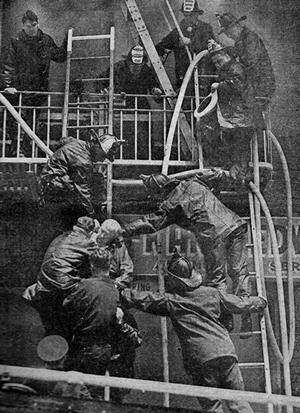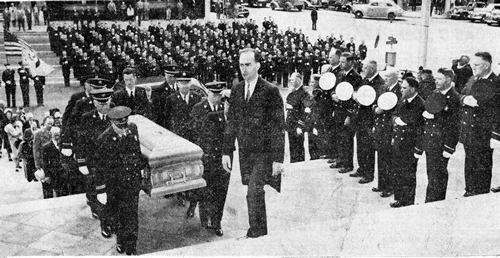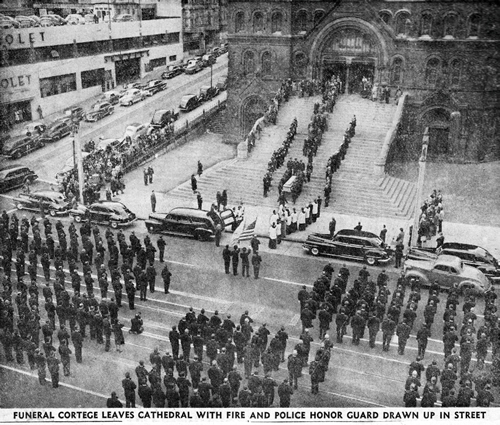
- Guardians Home
- SFFD Home
- Site Map
- Historical Review
- Apparatus
- Chiefs of Department
- Chronology
- Charles H. Ackerson
- Charles J. Brennan
- Keith P. Calden
- Andrew C. Casper
- Emmet C. Condon
- Robert L. Demmons
- John H. Dougherty
- Charles P. Duane
- Joanne M. Hayes-White
- George H. Hossefross
- Francis P. Kelly
- Frederick D. Kohler
- Joseph A. Medina
- Thomas R. Murphy
- William F. Murray
- Jeanine Nicholson
- Edward J. Phipps
- David Scannell
- Patrick H. Shaughnessy
- Albert J. Sullivan
- Dennis T. Sullivan
- Paul J. Tabacco
- Mario H. Trevino
- Edward P. Walsh
- Franklin E. R. Whitney
- Companies
- Events
- Past Events
- SFFD 150th Anniversary
- PPIE 100th Anniversary
- 1906 Expo
- 1989 Quake Party - 2009
- 65' Ladder Presentations
- Broderick & Terry Duel
- Coit Tower 75th Anniversary
- Cole Valley Fair
- Gold Hydrant - April 18th
- Jimmy's Car Show
- Lower Haight Street Fair
- Lotta's Fountain - April 18th
- Musters
- Presidio Car Show
- Station 28 75th Anniversary
- Fireboats
- Firehorses
- Firehouses
- Fires
- In The Line Of Duty
- Museum Collections
- Musters
- Notable People
- Organizations
- Gift Shop
- Volunteers
- Related Links
- Contact Us
- Research Requests
- Photo Gallery
- Videos
- Donations
SFFD - Those Who Died in the Line of Duty: |
|
UNITED AUTOMOTIVE SERVICE FIRE – 1414 VAN NESS AVENUE
Fatally stricken while fighting "Auto Row" fire at close quarters on second floor today, Battalion Chief Joseph Kane of District 1 is carried down ladder from fire escape by firemen. He apparently suffered heart attack. Battalion Chief Joseph Kane Served The City 26 Years Battalion Chief Joseph F. Kane, killed yesterday in line of duty, had been in the fire department 26 years. He was 54. MAYOR ROBINSON'S MESSAGE ON DEATH Mayor Robinson yesterday sent the following message to Fire Chief Edward P. Walsh on learning of the death in action of Battalion Chief Joseph. F. Kane:
FAREWEL TO A GALLANT FIRE FIGHTER By Will Stevens With devotion, his men laid to rest Battalion Chief Joseph F. Kane, who died literally fighting his heart out at the height of last Saturday’s half a million-dollar inferno at Van Ness Avenue and Bush Streets. And yesterday, during recurrent lulls in the impressive two hour ceremonies, men who served under him spoke in hushed tones – men like hoseman Bill Anderson and Lt. Harry “the Horse” Junge and Truck 13 driver Charley Long and hoseman Pat MacSweeney – and agreed “that’s how ‘Joe” Kane would have wanted to go.” WAS SYMBOL And only the Andersons and Junges and Longs and Mac-Sweeneys — and Kanes —-they knew, would understand. Fighting fires, and all the traditions, got in your blood after a while. And gray-haired "Joe" Kane at 54 was a symbol of the best that those traditions hold. The rites began at 9:30 a. m. with services in the Gantner, Felder, Kenny Chapel at 1965 Market Street, and it was not until a half hour later that six hundred uniformed firemen from all over the Bay area assembled, and solemnly escorted the hearse down Franklin Street, along Geary, down Van Ness, to St. Mary's Cathedral. There, a solemn Mass of Requiem was celebrated and Archbishop John J. Mitty chanted final absolution. Only a few blocks or so from the scarred and gutted building where the battalion chief died, ranks of white-gloved firemen, row on row, stood with heads bared while old comrades of the dead chief carried the copper-colored casket down the stone steps of the cathedral. The great bell of the church tolled. And then, through ranks reformed in front of City Hall, the funeral procession slowly passed, a wreath of white carnations on the casket now, and toward Holy Cross Cemetery. There, final graveside prayers were read. VETERANS THERE All morning, under overcast skies, a cold west wind had whipped those who had come to give their final homage. Waiting for the Solemn Mass of Requiem to begin, they talked in reverent whispers of the dead chief under whom they had served. Old veterans like Captain Richard R. Mow and Lieutenant Godfrey "Swede" Larson and Hoseman George Wyatt traded stories —"Joe" Kane asking to be returned to the hottest, toughest fire district in town when they made him battalion chief; "Joe" Kane ordering his men out of an inferno then going back in to take a last look himself "Joe" Kane coming out alive when nobody could understand why; "Joe" Kane, by precept and example, teaching rookies how a real fireman fights fires. All over the church, throughout the virtually capacity throng of worshippers, men he had taught watched the ancient rites unfold, men who had heard "Joe" Kane, tell them "follow me, boys!" or “get out of here before you’re all roasted hamburgers” Truckman Johnny Hazen, Hoseman Jack O'Connor, Truckman Frank Popich, Hoseman "Moon" Cotter, Truckman Larry Ruane, and all the others, to whom it still didn't seem possible that only eighty-three hours earlier, "Joe" Kane was directing them in a battle. RARE EULOGY And then the voice of Father Leo Powleson, pastor of St. Patrick's Church, was sounding a eulogy rare, on such occasions, and with an even more unusual observation: that "it was at Archbishop Mitty's personal request that this holy Mass was held. . . ." The priest, chaplain to the fire department, called Joseph Kane a hero who had laid down his life for his friends—and for a city. "Sacrifice," he intoned, "always has been wedded to heroism . . . but to make the supreme sacrifice, to lay down one's life for his friends—this reaches into the heights of heroism. . . . "Too often, citizens are inclined to proclaim the advantages of public service. Yet only eighty-three hours ago, a battalion chief was answering a call to duty—as he loyally had responded to hundreds of calls.... "Our Reverend Archbishop extends his appreciation to the services of Battalion Chief Joseph Kane, who fulfilled his duties to God, to country, and to church. "Our prayers. ..." Outside again, with the cold wind still blowing, the ranks reformed again. As slowly the casket came down the steps, Chief of Police Michael Mitchell bent toward Mayor Elmer Robinson and said softly: "He wasn't afraid of anything," and Fire Chief Edward P. Walsh, and others nearby, who had known "Joe" Kane, nodded. FAMILY PRESENT Following the casket, with her strapping sons, Joseph, John, and Robert, came the dead chief's widow, Mary. At the foot of the stone steps, she watched the casket placed in the hearse, and for a brief moment it seemed she would drop to the pavement. Archbishop Mitty, still in his robes, reached her side with a few steps, and spoke a few words. Then Mary Kane, with her sons, walked on and the homage to a city's hero neared its end. The battalion flag of the fire department, side by side with an American flag, was unfurled along the ranks of firemen, stretching three full city blocks. It was through these ranks that "Joe" Kane's body was transported and thence to his grave. MASS IS CELEBRATED FOR VICTIM OF VAN NESS FIRE By Larry McManus City officials, members of the department for which he had worked 26 years and fire chiefs from a score of Northern California cities gathered at St. Mary's Cathedral to honor the latest San Francisco fireman to lose his life in line of duty. Chief Kane died Saturday after he collapsed while fighting a four-alarm blaze on Van Ness avenue. FINAL SALUTE Some 700 firemen, military in their trim blue uniforms and white gloves, lined Van Ness avenue fronting St. Mary's Cathedral and later marched to the City Hall for a final salute to their dead comrade. Ranked alongside was a battalion of San Francisco police, their weapons held at present arms as the body of Chief Kane was carried up the steep cathedral steps. Lining the route followed by the eight pallbearers was Mayor Robinson, Police Chief Mitchell, city officials, and high-ranking firemen from San Francisco and other cities. The solemn pageantry of the requiem mass with The Most Reverend Archbishop Mitty presiding unfolded within the cathedral. Flickering light from six candles, taller than the four-man guard of honor they flanked, made a changing pattern on the casket as the ritual of the mass was sung. SKIES OVERCAST At the service's end the cortege, led by Archbishop Mitty and the clergy, left the cathedral under skies which had become overcast during the hour-long ceremony. Only the highest-ranking San Francisco firemen followed the procession to Holy Cross Cemetery where it was interred. Even as the bell at the cathedral continued to toll, fire sirens wailed over the crowd, a reminder to the firemen that theirs is a job without end. And as two officers returned from the funeral and parked their red sedan in front of the fire station behind the Old Mint another alarm rang out. Still in their dress blues, the, sedan carried them away to the new blaze. The department was back to full-swing again. And that's the way Joe Kane, described by his associates as a "fireman's fireman," would have wanted it.
Extracted from original sources with grammar and spelling as published. |




